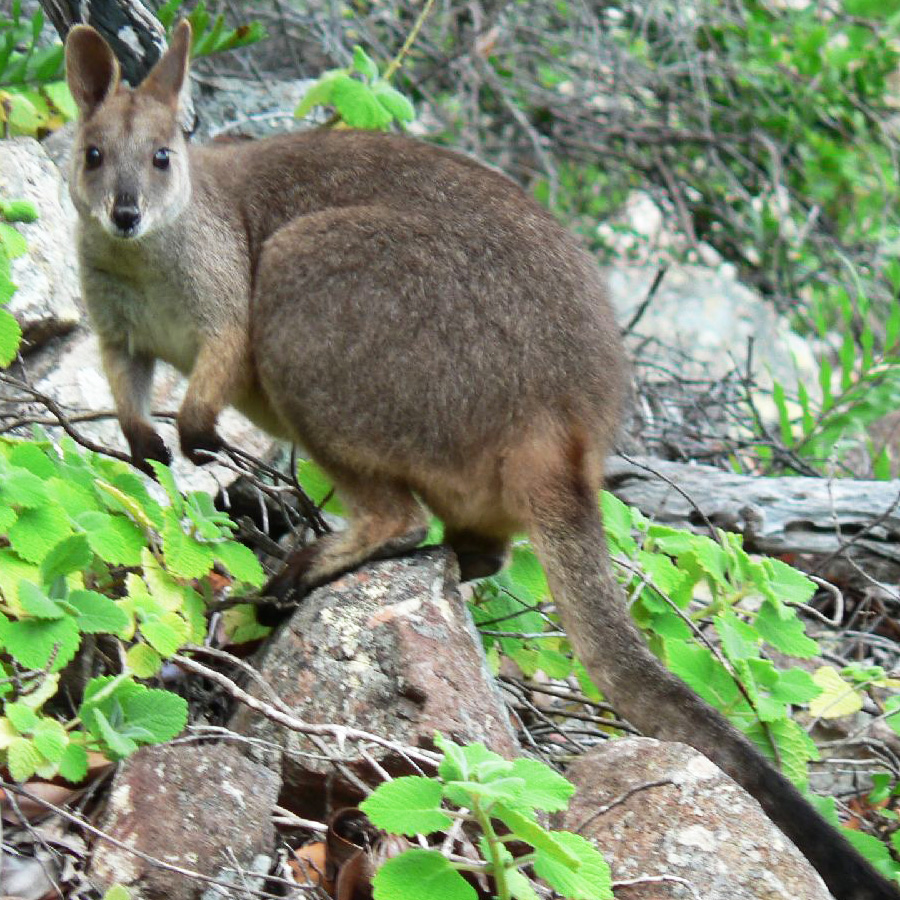Proserpine Rock-Wallaby
Petrogale persephone
Conservation Status
Queensland State: Endangered
Australian Government: Endangered
Species and status overview
Found in deciduous vine forest amongst rock piles and rocky outcrops on the mainland, the Proserpine rock-wallaby is arguably the best known of our local threatened species in the Whitsunday area. This species can only be found in select regions close to Proserpine and Airlie Beach and has the smallest known distribution of any rock-wallaby – known and total potential habitat is only around 17,000 ha. The Proserpine rock-wallaby is also the only known species of rock-wallaby to live exclusively in the rainforest.
The Proserpine rock-wallaby has been found to exist in 24 sites, including three primary sites – Conway Range, Mt Dryander, Clarke Range, and Gloucester Island. On Gloucester Island, the wallabies prefer a beachside habitat that allows them to utilise beach scrub, as well as rock piles and outcrops covered with dry vine scrub. Higher up they can be found in Acacia open forest.
Importantly, many of the sites which are home to the Proserpine rock-wallaby are divided by up to 20 km of terrain that is unsuitable habitat including urban areas, roads and cane farms. If habitats are lost, the wallabies are unable to naturally recolonise. Monitoring to determine the continued presence of populations and their condition at each site is critical.
Recorded habitat sites for the Proserpine rock-wallaby include
- Conway Range
- Dryander National Park
- Mandalay Point
- Clarkes Range
- Gloucester Island
- Hayman Island (population translocated)
- Mt. Lucas
- Mt Dryander
- Repulse creek
- Bluff Point
- Grimstone Point
- Pioneer Point
Description
Proserpine rock-wallabies stand less than 60 cm high and have a dark grey body and light grey chest and belly. The tail is brown with a white tip. Within hours of giving birth females will mate for a second time. They time the birth of their young so that the day after the elder sibling leaves the pouch permanently, the next young is born. Proserpine rock-wallabies can breed year round.
Opportunistic feeders, Proserpine rock-wallabies eat 142 different species of plants, including the leaves of trees, shrubs and grasses and fruit when available. They are nocturnal and considered cautious, making them difficult to trap and observe.
Conservation concerns
Common known threats include
- Habitat clearing
- Vehicle collisions
- Predation (feral dogs, dingoes and domestic dogs. A recent (2012) incursion of the red fox may also pose a threat as it has to other wallaby species)
- Disease (including toxoplasmosis spread through cat faeces and hydatid tapeworms from dogs)
- High intensity fire in dry years
- Toxic garden plants
- Climate change
What can I do?
- Keep dogs fenced and cats indoors and do not give cats raw meat. This can cause them to contract and spread toxoplasmosis
- Raise awareness of the Proserpine rock-wallaby within your community
- Remove toxic plants from your garden
- Restore existing habitat and improve connectivity between patches of habitat
More Information
- National Recovery Plan for the Proserpine rock-wallaby
- EHP
- ALA
- Plants suitable to rehabilitate native habitat and plant species that may be toxic to the Proserpine rock-wallaby
Photo captions Proserpine Rock Wallaby NPRSR2, Proserpine Rock Wallaby NPRSR3, Proserpine Rock Wallaby NPRSR
